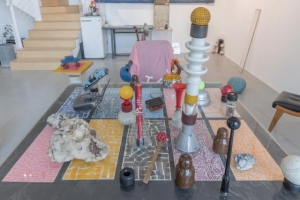AirMax925: Maxime Machaidze’s Solo Exhibition
“...The libraries of combinations standing in the wind like vending machines of stars.”
The Window Project gallery presents Maxime Machaidze’s solo exhibition AirMax925. It puts on display a long-term research process and its results in the form of objects found and collected at different periods of time- “toys”, accessories and garments. The show focuses on pawnshops and vending machines, which thanks to application of a special software, allow customers to purchase the goods and experiences. In some cases, the software surprises visitors. Interactive works give the audience a chance to get involved in the creative process and at the same time transform it into a research object itself.
The title of the exhibition derives from Maxime Machaidze’s recently acquired nickname and musical stage name KayaKata (AirMax runs 925 on KayaKata’s bass). This composite word unites signs of the present identity of the artist who is undergoing a process of self-exploration. Associations that are generated as a result of reading these signs first take us to the realm of urban culture and later give birth to different interpretations. At last one understands that “this is not a pipe” and tries to make sense out of elusive, highly electro conducting coded features of avatars that are born in the same body over and over, followed by the emanation of the heroes and synthetic elements of the robots. In may also happen that during the process a person does not even attempt to grasp the meaning and starts to question existence of a borderline between a human and added or replaced robotic identity that becomes part of the process of transformation into verbal robotization.

Freedom which is born in the eternity of combinations can be considered one of the most important concepts of this exhibition, especially in connection with the designed objects –Maxime’s toys. Modification and rearrangement of the works make it possible for the objects to gain or lose new functions. This may also contribute to shifting of the moment of reaching the finish line to the point of uncertainty. Presented design has no function of its own anymore and takes on temporary ones thanks to its existence next to a specific person and the process of transformation that influences it through individual actions of different players and their manifested creative abilities.
Parallel play with the object of different functions sometimes turns them into functionless ones that engage in a dialogue with each other in order to take on a new function (abundance of variations liberates creative skills) and “nothingness” as a concept and aesthetic notion. And again, this is not a pipe!
While attempting to “read” these works one gets an impression that Maxime develops the same attitude towards the toys as towards his body and different heroes who have manifested themselves in it at different periods of time. During the process, unconscious elements of a children’s game synthesize with the philosophical concept and diverse spiritual experiences: as soon as the heroes are revealed on the one hand very naturally and on the other hand because of the specific features and criteria,intuitive actions of creation of works start to merge with certain codes and selection criteria/formulas.
Each element of the presented works and displayed objects uses colors to establish a dialogue with each other. Here, one won’tbe able to find random colors that are not integral part of an established palette.
In parallel the objects bear the traces of wear, history and changes that happened as a result of a dialogue with the universe transforming them into a new entity that differs from the baseball ball or an armchair.
Aesthetic side of the exhibition is based on the concept of deriving pleasure from watching of ephemeral, imperfect, temporary beauty – the Wabi-Sabi philosophy.
The exposition also displays the objects, which were accidentally created by nonprofessional “designers”. For example, the “designer” items that were discovered next to the scrap metal storages and assembled from different pieces of junk in order to give them some function. No one has ever reflected on their design as they were created thanks to intuitive combination from objects of different aesthetic value. For Maxime they remain interesting only during the period of time when their creators work based on their intuition. He just watches the process, changes the context and later transforms them into his own works.

For Maxime Machaidze creation process is defined by a specific combination of spiritual experiences and local identities, western ready-made and conceptual art, oriental philosophy, anime and comic strips. As a result, the exhibition unites the works that meet each other or reunite in the pawnshops which have become inseparable parts of Tbilisi.
Abundance of the pawnshops that form a tragedy of the city andserve as a demonstration of its difficult social backgroundpopping up at different locations like “poisonous flowers” establishes own aesthetics. The stores turn into the places which bring together objects of different function and origin. They become part of the “winters spent at the pawnshop” and circulation of “cash cash”. During the period the objects are stored at the shops they lose their function that can be restoredyears later. In the process they can lose or be awarded new value, become useless or on the contrary become more interesting in the hands of a new owner.
The exhibition presented at the Window Project gallery showsthat Maxime Machaidze’s musical voice and visual “Katana language” offer different ways of expression that is created as a result of a common process and changes along with alteration of the heroes who are born in the same body.
Artist: Maxime Machaidze
AirMax925
Feb 15-March 25
E. Tatishvili 9











